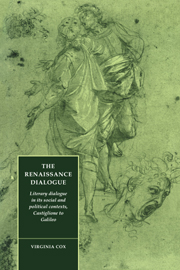 The Renaissance Dialogue
The Renaissance Dialogue Published online by Cambridge University Press: 05 December 2011
… qui princeps est sermonis … is nostram de rebus putatur aperire sententiam
Carlo Sigonio, De dialogo liber (1562)‘It will be assumed that whoever is the main speaker in the dialogue will be expressing the views of the author.’ This statement of Sigonio's, with its calm assumption that every dialogue will be ruled by a princeps, is a good indication of how far the dialogue of the later sixteenth century had travelled since the relatively ‘democratic’ model of Castiglione's day. The chapters which follow will be an attempt to account for this change, in the light of contemporary developments in cultural politics and intellectual practice.
Before embarking on this more specific task, however, it may be useful first to trace a brief history of the dialogue form in the Italian Cinquecento. That such a history is needed cannot be in doubt. Despite a recent revival of critical interest in the theory and practice of the Cinquecento dialogue, there has been no very convincing attempt, to date, to trace the history of the genre throughout the century. Trajectories have been tentatively proposed, changes and turning-points identified; but no single study so far has taken account of a sufficiently broad and representative range of examples of the genre to produce much more than summary and partial conclusions.
What follows is by no means intended as an attempt at a comprehensive survey of Italian Cinquecento dialogue production.
To save this book to your Kindle, first ensure [email protected] is added to your Approved Personal Document E-mail List under your Personal Document Settings on the Manage Your Content and Devices page of your Amazon account. Then enter the ‘name’ part of your Kindle email address below. Find out more about saving to your Kindle.
Note you can select to save to either the @free.kindle.com or @kindle.com variations. ‘@free.kindle.com’ emails are free but can only be saved to your device when it is connected to wi-fi. ‘@kindle.com’ emails can be delivered even when you are not connected to wi-fi, but note that service fees apply.
Find out more about the Kindle Personal Document Service.
To save content items to your account, please confirm that you agree to abide by our usage policies. If this is the first time you use this feature, you will be asked to authorise Cambridge Core to connect with your account. Find out more about saving content to Dropbox.
To save content items to your account, please confirm that you agree to abide by our usage policies. If this is the first time you use this feature, you will be asked to authorise Cambridge Core to connect with your account. Find out more about saving content to Google Drive.